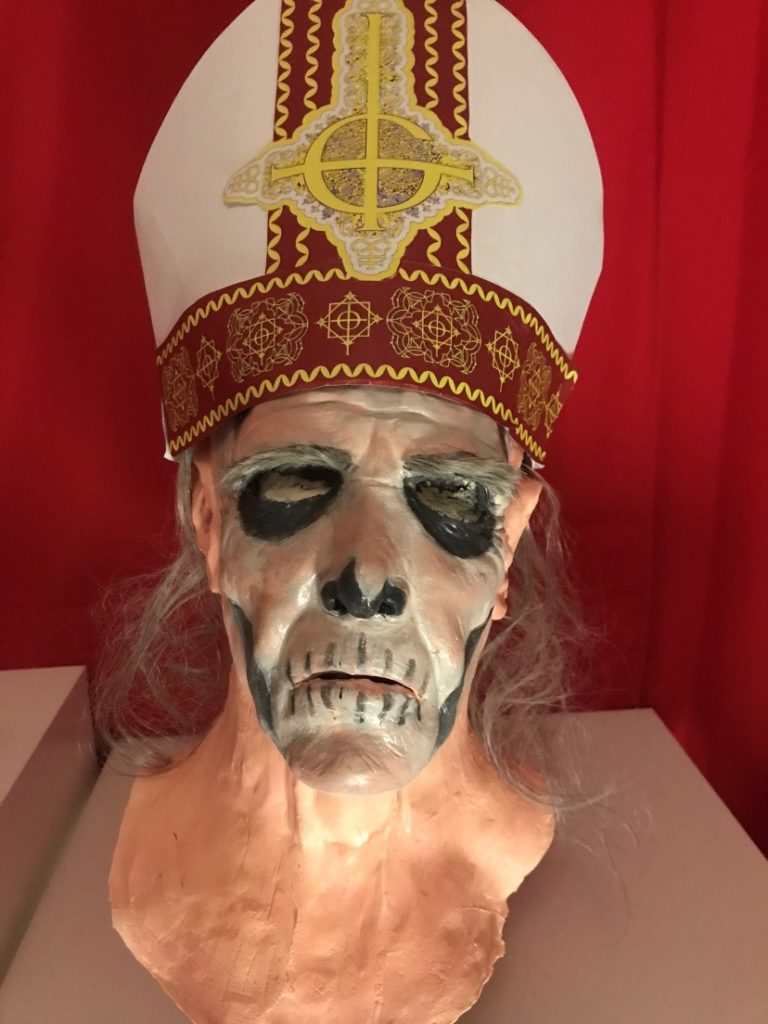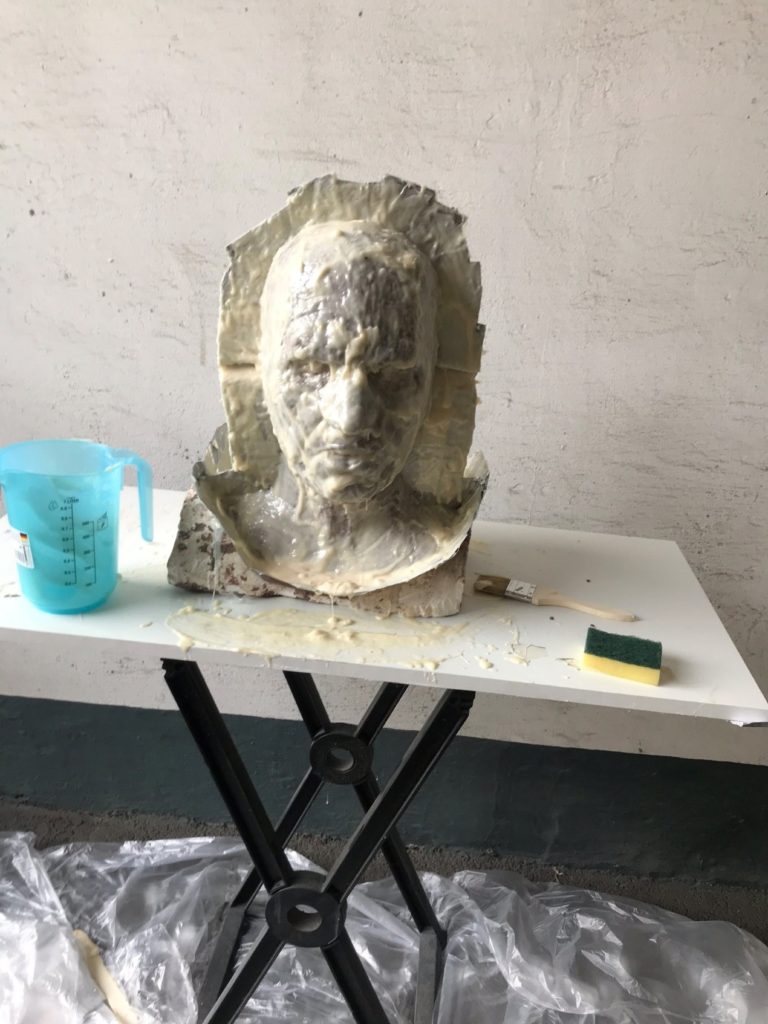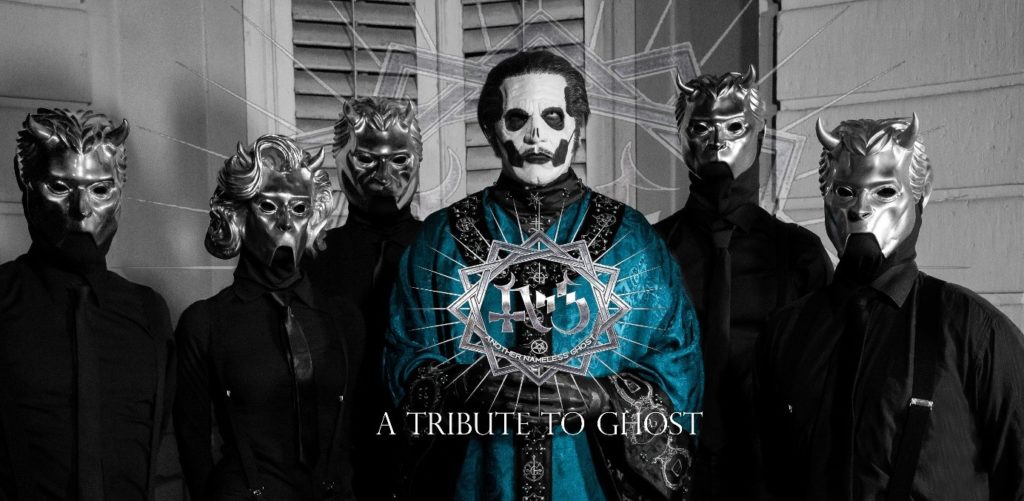Mike Corneleone – the man behind the masks

We had the pleasure to talk with one of the greatest mask builders in the fandom. Mike Corneleone is a makeup and costume artist.
His work is mainly known in the context of the band GHOST. As a fan of the band he makes many GHOST inspired replicas which are mainly used by the German GHOST tribute band “Another Nameless GHOST”.
***
Hello Mike! Thank you for taking your time and talking to us. Let’s start with the very beginning. How and when did you first become aware of GHOST and what has convinced you about them? What do you wish for the new album and the hopefully soon following European tour?
In the summer of 2016 I had an appointment with the tattoo artist. The studio was very dark in appearance with lots of bizarre artifacts. The guys who worked there looked very creepy too.
I sat for the tattoo for 4 hours and during that time the entire GHOST discography went up and down. I asked the tattoo artist if it was a band of Satanists … and he just said yes, they are totally creepy and really evil. Nobody knows who they are and they change the singer after each album.
After the appointment, I couldn’t get the songs out of my mind and was totally GHOST infected.
I’m looking forward to the new album. Many are mostly disappointed that GHOST evolves more and more into the mainstream with each release, but I think you have to look at each one separately.
GHOSTs usually never repeat themselves with their works, but always change. In the end I think we will get a big album again. The new song “Hunter’s Moon” won me over immediately. The song reminded me of horror films that I saw as a kid in the 80s.”
You create and design head masks of the Papas and the Cardinal yourself. The resemblance to the original masks of the band are enormous. You seem to have an eye for details. How did it happen that you started making masks? Was there a particular reason?
In the city Düsseldorf, Germany, we have a small local festival in which the musician scene takes part. It is called COVER ME BAD.
The concept is that the participating musicians suggest songs that they would like to cover. Then other musicians who are also interested get in touch.
They meet once for rehearsals and finally the songs are played in a constantly changing line-up on the evening of the event. Costumes also play a major role in the presentation. Friends of mine played Ritual of GHOST and I got into it a bit to get the costumes for them. Everything was still very low budget.
Glued-on paper crosses and PE II latex mask from Trick or treat studios. Everything was fine, but he could hardly sing through the mask. After the guys said they would like to continue acting as a GHOST tribute, I began to be interested in how you can make masks yourself. From then on it was always based on the principle, let’s see how far i come.
How do you start a new project? Are you someone who plans everything in advance or do you just go for it?
In the meantime I have my projects clearly in mind and know what I actually want to do next. In any case, my goal was to have all of the papa masks as silicone masks. I have now done that except for the Papa I and Papa Nihil mask.
However, the start of the process is mostly spontaneous. It only occurs to me too late that I would have better prepared my workplace first.
What materials do you use for your masks? I would imagine it is not a cheap hobby?
No, it is not cheap and there is always something that has to be bought. The materials, especially since I’ve been making silicone masks, are very expensive. If something goes wrong, it hurts even more.
I started with Latex masks back then. As a rule, they are easier to manufacture and the material is also much cheaper, but they often look less realistic.

ⒸMike Corneleone 
ⒸMike Corneleone 
ⒸMike Corneleone
Can you explain what steps are needed to create a complete mask? What problems do you have to deal with? What do you prefer to do?
It depends on. A normal average head dummy is actually sufficient for a latex mask. You start to shape your mask on this head with clay or oily plasticine and work on the sculpt until you are happy with it. Then you are going to make a negative mold of it, for which you can use hard plaster or resin with fiberglass pieces.
After all, when everything is cured you can remove the mold from the sculpt. then for example, you can pour latex into the mold. Repeat this step so often until the mask has reached its desired thickness. When everything is cured you can pull the mask out of the mold and then paint and work on it.
The process for a silicone mask is much more time-consuming and complex.

ⒸMike Corneleone 
ⒸMike Corneleone 
ⒸMike Corneleone 
ⒸMike Corneleone
What kind of hair do you use? Is it human hair or artificial hair? How is the hair attached to the mask?
Sometimes I get leftover hair from my hairdresser, but mostly I buy artificial wigs or hairpieces. Most of the hair is glued to the mask in individual strands, for which I use a silicone adhesive. Beard, eyebrows, sideburns and hairline are individually pierced into the mask with a specially prepared needle.
How many hours of work do you usually need for a mask? I guess it probably depends on how detailed a mask is? Maybe you can give us an example of how long it takes?
The entire process from sculpting to molding to casting and finishing a mask can take months. Sculping especially takes time. At least when I try to recreate masks, I think I could be faster with my own projects. But often you need a bit of space to continue working on the busts. I worked on my last Papa II silicone version for over a year with a break.
The production of the mask from a finished mold takes about 2-4 days. I seldom have the time for this in one go because I work full-time and am also a father.
How many masks have you already made? Can something go wrong and the mask is ruined? Can masks be repaired afterwards?
I think I’ve done maybe 50 of the latex masks so far. Many failed attempts would also be there. Silicone masks about 10-15. I made my first working one about a year ago.

ⒸMike Corneleone
I’m still at a point where every new mask is a challenge for me. I don’t have a workshop but work at home. The material is often poisonous, sticky, greasy. In any case, I leave a cracked choas after every mask that has to be removed again first.
Furthermore, something can always go wrong; the mold must be thoroughly prepared. You need enough materials to weigh and mix by hand, because once the material is mixed in the components time is ticking and you have to carry out the steps quickly, otherwise the material will begin to harden prematurely. That is why the outside or room temperature must always be taken into account … there is so much more that needs to be considered so that you do not fail with the mask.
Small air bubbles or cracks are relatively easy to repair. If something goes completely wrong, you still have the opportunity to get creative and make something completely new out of it.
Can one buy your masks or commission a mask from you? Or do you do it primarily for the fun of it?
First and foremost, I do the masks for myself or the tribute band. I like the idea that my masks are rather rare and not always available everywhere. Especially related to the band GHOST. A special plus that Another nameless GHOST have as a tribute is that they can use my masks and costumes largely exclusively.

ⒸMike Corneleone 
ⒸMike Corneleone 
ⒸMike Corneleone
I have occasionally made silicone masks for nice people from the community, but I’m very picky and I set some rules for most of them. The most important thing is, no mask for other tribute bands!
Next year I want to start my own business and I will also officially accept orders and sell masks. Let’s see where that leads.
Are there certain things you should consider when storing masks? Do you need to take care of the material so it doesn’t become porous?
It is always good to put on a mask on a suitable head bust. With a silicone mask it is ideally the core that was used as positive to the mold, as the silicone then adapts to this special core, as with sculping.
If you have your own Lifecast of your head, this is the best solution because the mask will always keep its shape.
Have you ever had the opportunity to see GHOST masks up close, for example at an M&G? How do you like them? Would you do anything differently?
Unfortunately not yet. I have collected tons of photos of the masks over the years and have been to some concerts where I was always fascinated by the masks, but never up close.
Would you like to create a mask for GHOST? Which Papa would be your favorite? Or would you rather want to design your own mask for them?
HAHA…no tbh …I’m not good enough for this. I wouldn’t like to have the pressure to make something that has such a weight for the project. For the tribute I created a mask that was inspired by the artwork from the illustrator Randi Lang. It was her vision of a possible Papa IV before the cardinal appeared. This one has fascinated me and so I started to sculpt this mask to bring him to life. The tribute called him “The bastard of Papa Emeritus II” and he became an origin character of the tribute band. I still love the idea and the mask.
You also sew the robes of the Papas. Since there is no pattern, how do you approach such a project? How do you find a fitting fabric like the original?
It’s all research. I search through forums and now I know some dealers who sell special church fabrics. Unfortunately, most of them can only be found in the USA, which is why getting them is always quite expensive and time-consuming. In addition, GHOST now use fabrics that are very rare, whatever doesn’t make it any easier. Actually, I hate sewing and I’m not very good at it either. It’s mainly by eye. You could also say that in many cases I don’t know what I’m doing.

ⒸMike Corneleone 
ⒸMike Corneleone
After GHOSTs Mexico Show 2020 I started to deal with the project to recreate a Papa IV robe. My first impulse was … that’s impossible. You could see in the few pictures that there were so many details about it. Over time, however, better and better recordings of the concert began to appear. I started researching the material and finally found it by chance.

ⒸMike Corneleone 
ⒸMike Corneleone
The embroidery was far too fuzzy for the photos to be used for embroidery templates, so I traced them and created templates myself. That was very time-consuming, I knew that at best I would only get close, but the original ones would be much more complex. In the end I was very satisfied that they are still very similar to the real ones.
There are over 100 embroideries on the robe and I worked on it for over a year, so it was clear to me that this is the first and only one I will make of it.
Do you also do the embroidery yourself? How exactly does that work?
Yes, when I started making the costumes. I had bought a “Singer Futura XXL 400” embroidery machine. This is a relatively old model and the software doesn’t have many options. I finally started to recreate the GHOST embroidery templates and make my own. So I am able to do the embroidery of the costumes myself. But with Papa Nil I reached my limits and therefore gave up the project.
Tell me about your collaboration with the German tribute band „Another Nameless GHOST“. How did it come about?
Well…I know them.. they are friends 😉

Now you made us curious. Maybe we should have a closer look at the tribute band next time. 🙂
Thank you for taking your time. We can’t wait to, see more of your incredible work!
Here you can find Mikes Instagram Account:


